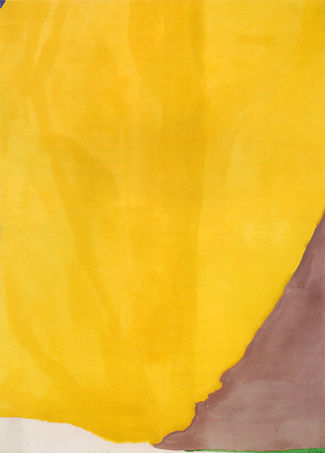Sun Mountain
"Sun Mountain" is a acrylic abstract painting by Helen Frankenthaler in the permanent collection of the Birmingham Museum of Art. At just over ten feet tall by seven and a quarter feet wide it is among the more monumental works on display in the American gallery.
Frankenthaler sketched landscapes during frequent hikes around her home in Darien, Connecticut and was apparently inspired by natural scenes, though in her work these inspirations are transformed into lyrical abstractions. At the time she made this work, she had been married for 10 years to another abstract artist Robert Motherwell.
Frankenthaler worked alone on large-scale canvases on the floor of her studio. She used acrylic paint thinned down to the consistency of watercolor to build up large, modulated fields of color which also soak into the unprimed canvas, providing a range of depth and luminosity while also emphasizing the flatness of the picture. Among her goals in painting was to make the process invisible. She discarded paintings that started to look "over-labored.'
Most of the surface of "Sun Mountain" is coated in a deep yellow tint, with a purplish-brown area in the lower right corner. At the very bottom edge of the painting an area of raw white canvas is separated from the yellow field with a pale white strip of paint, and from the purple area by a narrow strip of bright green. At the top left corner a tiny peek of deep blue appears at the very corner of the frame.
The interrelationship between landscape depiction and abstract composition was remarked upon by critics, such as E. C. Goosen of the Whitney Museum of American Art, who said of Frankenthaler that, "no matter how abstract her paintings, ... they never quite lost that hereditary connection with the world of nature and its manifestations."
The painting was given to the museum by Mrs Charles Ireland in 1993. In 2017 then-curator of American Art Graham Boettcher put "Sun Mountain" on display beside Albert Bierstadt's well-loved monumental landscape, "Looking Down Yosemite Valley", painted a century earlier. The juxtaposition highlighted the many similarities in the spirit and expansiveness of the two paintings while also contrasting their modes of expression.
References
- Antoon, Donna. "Sun Mountain" in Birmingham Museum of Art (1993) Masterpieces East & West: From the collection of the Birmingham Museum of Art. Birmingham, Alabama: Birmingham Museum of Art. ISBN 0931394384, p. 252–253
- "What’s Up at the BMA: Yosemite Meets Sun Mountain" (June 24, 2017) Birmingham Museum of Art
External link
- Sun Mountain at artsbma.org
